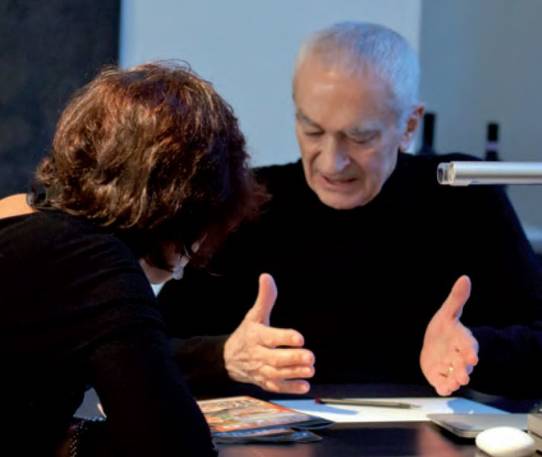


His house speaks of the past, but also the present. This little universe is where Massimo Vignelli lives and works. He is a design world icon, though he cringes when I call him this.
We sit at his desk: a plate of metal on a stand. These plates are found all over New York,covering holes in the streets during repairs to the grid and sewer systems, strong enough to support the weight of a truck. “Timeless objects are made with simple materials and minimal work, work is expensive…” It’s hot, but the metal cools us down enough to have a long and passionate conversation.
We speak of design, all things related to design, how design affects our lives. On one hand, there are so many things on the market created to be consumed and replaced; on the other, there are objects that remain, thanks to their timeless qualities. This is the first in a series of conversations dedicated to the ideas and objects of design, starting with the concept of timelessness. That is, when a design is born and lives to be timeless.
“Before speaking of timelessness we should differentiate between design and styling. Design, when it’s a good design and possesses all the qualities of the perfect design, lasts over time, which is its fundamental requirement. Styling is ephemeral by nature, it is whatever is in style. The concept of timelessness refers to long duration and has a basis in “responsibility”. The designer’s responsibility toward the user and toward him or herself consists in operating in such a way that things don’t get thrown out. True design is not disposable. Styling is “disposable”. Design has a logic, skeleton and musculature of its own.”
These words define the entire public and private life of Massimo Vignelli and Lella, his wife, an architect and his companion in both work and life. Both of their lives are characterized by design; they live it down to the smallest details. It even determines the clothes they wear, their accessories, their linens.
Let’s begin by quickly confronting the idea that design is an unattainable world and that, especially in today’s times of crisis, it can seem like a luxury, or a way of life for the few and the rich. But can’t design—timeless design—be a way of saving? Saving signs, materials, energy, and even money? If design lasts, then in these times it could be useful to reflect on the lasting power of our purchases. On whether they are necessary or if they serve us.
“Of course design can be a way of saving—and it must be! Good design is above all economical—economy is its fundamental component. In the absence of economy we have styling. Design is the most direct way of achieving a goal, it doesn’t tolerate waste. True design is ethical and moral. Styling isn’t—it’s the opposite. Styling is freedom without limits and confines. Design, on the other hand, proposes these confines, it has its own protocol and can be very severe.”
So is design just a world of rigor? Rigid and tedious? “No. Design can also be very lively, cheerful, playful. But it’s a joy that derives from intelligence, not emotion. And that’s another big difference between design and styling. It’s not that emotion is necessarily separate from intelligence. There’s a relationship between them. Every work evokes emotion. But when emotion derives from the intelligence of the work’s creator, it has a staying power, and that’s timelessness. When a work is only emotion, on the other hand, everything fades after the initial impact. It’s like an orgasm, fleeting...”
I endeavor to draw a comparison. Is it like the difference between Falling in Love and Loving, as in the book by renowned sociologist Francesco Alberoni? Massimo smiles, amused.
“Love is timeless, being in love is ephemeral. The relationship between timelessness and the ephemeral is also the basis for the discourse on design. Our lives are ruled by this dichotomy. Timelessness and the ephemeral. It impacts everything. From choosing a utensil to choosing a whole piece of furniture. A choice based on timelessness will last a lifetime, but an emotion-driven choice will last only a few years. You have to filter everything that passes in front of you, everything you see. The worthwhile lasts, the unimportant passes. The same is true for music, literature, not just for design.”
Now Massimo Vignelli is on his way to give seminars at the Vignelli Center for Design Studies at the Rochester Institute of Technology. We’ll continue our conversation in issues to come. As we say goodbye, I take a closer look at his desk. I can’t help but noticing one of his drawings. It depicts, in minute detail, all of the (few) objects he plans to take with him. From his suitcase to his socks, from his toothbrush to his iPhone charger…. Design is part of his private life. His life. Down to his list of things to pack.
Source URL: http://ftp.iitaly.org/magazine/style/articles/article/massimo-vignelli-timelessness-essence-design
Links
[1] http://ftp.iitaly.org/files/vignelliairos1385094818jpg